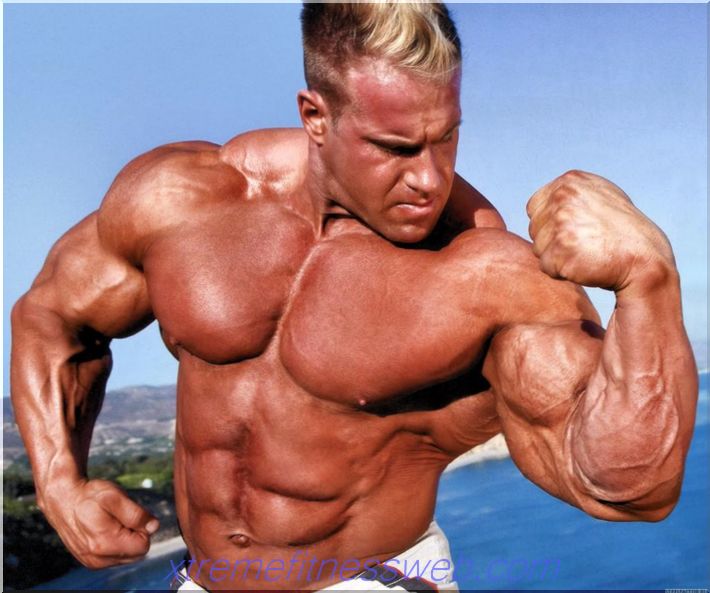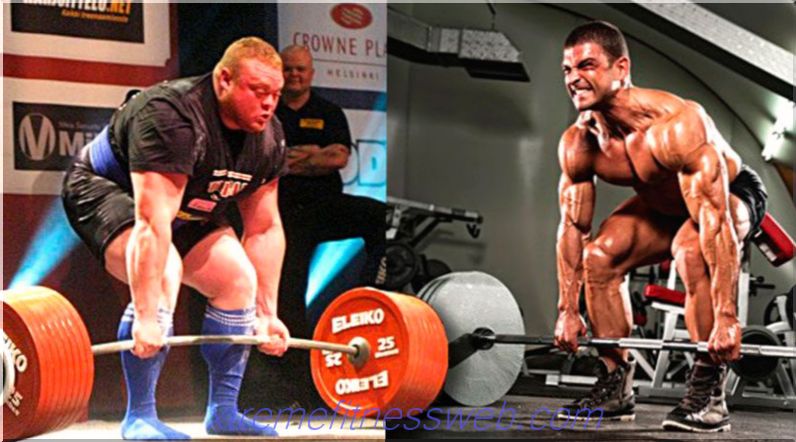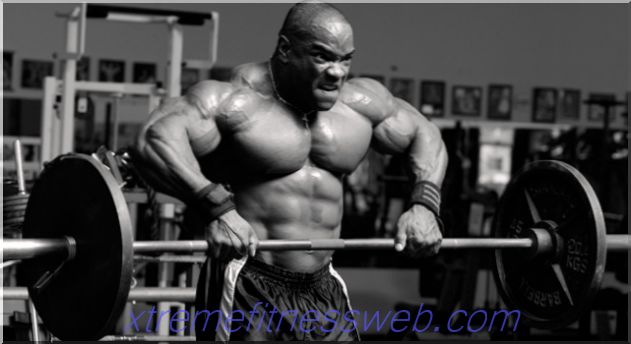- Why do you need to do this exercise?
- Possible options for pulling the bar to the chin
- Exercise variations
- Possible problems and solutions
- Classic errors

The pull of the bar to the chin is an exercise for the development of the trapezius and deltoid muscles. The closer the grip to the width of the shoulders, the less trapezoids work, and more - deltas. Some athletes consider the movement to be a hybrid of the scrub and the breeding of dumbbells while standing, but biomechanically it is closer to the push pull used in power disciplines. The movement is natural, it is used in everyday life to lift a heavy object from the floor, and put it on the table. In bodybuilding and fitness, it can be performed with a barbell, a curved barbell, dumbbells, a shock absorber and on the bottom block of the crossover.
Content
- 1 Why you should do this exercise
- 2 Possible options for pulling the bar to the chin
- 2.1 Rod with rod
- 2.2 Traction on the block
- 2.3 Work with dumbbells
- 3 variations of exercise
- 4 Possible problems and solutions
- 4.1 Wrist discomfort
- 4.2 Shoulder pain
- 4.3 Elbows do not rise above the level of the shoulder head
- 5 Classic Mistakes
Why do you need to do this exercise?

Shoulder training may include a barbell or standing dumbbell bench press, abduction of arms with dumbbells while standing and leaning, swinging with dumbbells in front of you. Trapezius muscle training is a shrug. The pull of the bar to the chin or broach with the bar - a hybrid exercise involving the middle bundles of deltoid and trapezius muscles in the work.
The broach should be included in the training plans, that's why:
- When lifting weights from the level of "pockets" to the chest, medium bundles of deltas work;
- When the bar is brought a little higher - the trapezoid
Important: traction technique is selected, depending on the purpose. Women can not display the neck above the chin. Men, and those who want to develop a trapeze for sports purposes - to perform high traction.
In the training plan, the exercise goes after the shoulder presses. Its goal is not only to load the middle bundle of the deltoid muscle, but also to balance the impact on the athlete’s joint. The traction variant for trapezoid is sometimes called “high traction or high traction”. A version with a lower neck position - traction to the chin.
Sometimes an exercise is called a broach, but according to the technique it differs from a weightlifting pull, and what is performed in power extreme. In weightlifting, the goal of the exercise is not only to bring the barbell to the chin, but also to raise it higher, therefore, after lifting the barbell to the level of the chin, the bar grabs and the weight is pulled out with a push or jerk over your head. Technically, this is a different, more complex movement.
Possible options for pulling the bar to the chin
Options vary depending on the projectile, you can perform the exercise with dumbbells, a barbell, on the lower block of the crossover, or even with dense rubber shock absorbers.
Barbell rod

The warm-up approach is performed for 15 repetitions with a light weight. The value is relative - for some, a 20 kg bar will be ideal, others will need a 16 kg barbell, and the third will need a pair of 5 kg dumbbells or a body bar. It all depends on the strength indicators of the athlete. The goal of the warm-up approach is not muscle fatigue. It is necessary to increase the amplitude of motion in the joint, and warm up the muscles and ligaments.
The bar should be installed on racks at a height just above the knee. You can place it on the safety stops of the power frame, if convenient. Flexible athletes can take weight off the floor.
The technique is as follows:
- The shell is taken with a grip shoulder-width apart, fingers grasp the shell, open grip is prohibited;
- The body is stabilized, the shoulder blades are brought to the spine, the back is straightened. By the force of medium deltas, the bar reaches the middle of the chest and above, to the chin;
- During movement, the bar can slide over the body;
- Palms look towards the body, elbows extend above the line of the shoulders;
- When the elbows reach the plane of the shoulders, there is an option to raise them even higher, and turn on the trapezoid, or start lowering the projectile to leave the predominant load in the deltoid muscles
Working approaches are performed for 10-12 repetitions, warm-up - for a larger number. This movement is not done in the power mode, the trapezius muscles will do the predominant work, there is a risk of injury, and you won’t work out your shoulders qualitatively.
Block pull

Features of a broach with a crossover block - more options for organizing a drop set, a softer bar movement, and a smooth ride, as well as training with low weight weights. The option is loved by a fitness bikini, and by everyone who does not like to wait for free racks and a barbell. It is often combined with other exercises on deltoids, for example, it is performed by a superset with traction on the posterior bundles of deltoid muscles. The option can be carried out with a straight or curved handle for easy grip.
The thrust in the block simulator can be performed with a straight handle, then a narrow grip is permissible. It allows you to maintain balance in work. In order to pull it was convenient, you do not need to step too far away from the simulator. It is enough to take a small step back.
Important: there is an opinion that women need to do only 3 working approaches from 15 repetitions and exclusively on the block. In fact, it all depends on the purpose of the training, and the phase of the annual cycle. You can also perform 8-10 repetitions with a barbell, if the athlete allows strength indicators. Special "male muscles" will not grow from this.
Work with dumbbells

Dumbbells are convenient in that they allow you to harmoniously develop both deltoid muscles. If an athlete works with a barbell, his dominant hand leads, and “pulls” the weight stronger, as a result, the lagging one does not receive enough load. Therefore, you should periodically include unilateral (one-sided) training or exercises with dumbbells.
Dumbbells can be pulled like a barbell, that is, simultaneously, or one at a time. The second option is used less frequently, and in relatively professional training. Usually, not only professionals work with dumbbells, but also beginners who are just too hard to carry out exercises with a barbell.
Exercise variations

There are two main variations - traction with elbows that do not rise above the plane of the shoulder joint, and traction with elbows above this plane. To work with the barbell in a variety of techniques, you must actively include the muscles of the shoulders in the work, that is, provide yourself with an understanding of this work. In practice, beginners pull with a trapezoid, and this is normal, since in the human body it is this muscle that “starts” when the weight is lost from the position of the hang. For those who need to work out their shoulders correctly, there is a simple trick - you carefully spread your elbows to the sides and pull exactly to the point where the elbows are at shoulder level. If only the trapezium feels like working, you should perform the exercise with less weight, and with an emphasis on breeding the elbows slightly to the sides on the rise.
Possible problems and solutions

Wrist discomfort
It can be a real pain. The athlete experiences it in two cases, if her wrists are too bent, or if his joints are not ready for the load or are overloaded from bench presses. In this case, you can wrap the wrist bandages, or use a curved neck or handle for the crossover.
Shoulder pain
The question is where the pain is localized. If she "shoots" from the muscles in the joint, from the biceps and deltas in the shoulder joint, you should refrain from exercise. This means that the athlete may have received a sprain, therefore, cannot actively train. It would be better to refrain from training until the body is fully restored.
If the pain resembles the discomfort in the joint itself, perhaps it is simply a lack of warm-up. It is enough to do 8-12 rotations in the shoulder joints to get the proper effect.
Important: any “shooting” pain should be a signal to stop the exercise. Such sensations mean that a person may be injured.
Elbows do not rise above shoulder level
This may be a sign of insufficient flexibility, or poor development of mobility of the shoulder joint. Sometimes such symptoms occur with arthrosis of the shoulder joints, sometimes with arthritis. But this can also be due to the enslavement of the joint due to the predominant development of the muscles of the chest. Flexibility and mobility can be developed by performing lead-up and specially-preparatory exercises. Sometimes mobility is acquired by ordinary rotations in the joint, sometimes stretch marks are required.
Classic errors

Typical errors are:
- Rocking the body and cheating . No need to repeat everything that is shown in the video pro-athletes. These people have an ideal sense of the body, and can perfectly regulate the load in any situation. Beginners often try to lose weight by inertia, so they get a negative result;
- "Curve" posture . Flexion of the spine is a bad option for all standing strength exercises. You need to stand, bringing the shoulder blades to the spine, and actively reducing the press. This will help get rid of the "hump" and lean forward;
- Too much weight . The main reason for cheating, bending your back, and other mistakes is to re-evaluate your capabilities. It is necessary to actively include the abs, legs, stabilize the back and lift due to the deltoid and trapezoid, and not by inertia;
- The bar goes vertically, but far from the athlete’s body . This can lead to the inclusion of the anterior bundles of the deltoid muscle, and disruption of the trajectory of movement. The main problem is overload of small muscles and possible injury.
Paying due attention to technology, you can perform this exercise effectively and develop muscle.







